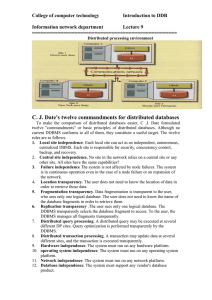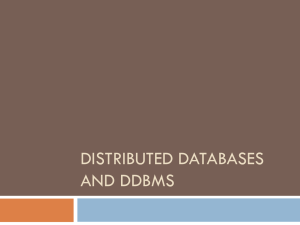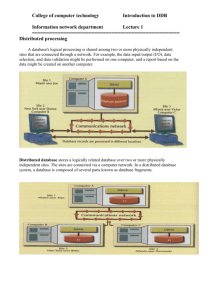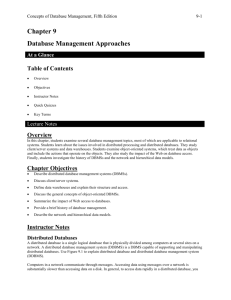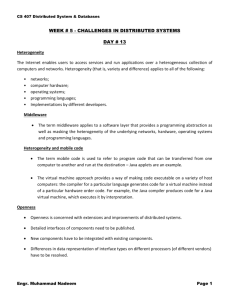Distributed Databases
advertisement
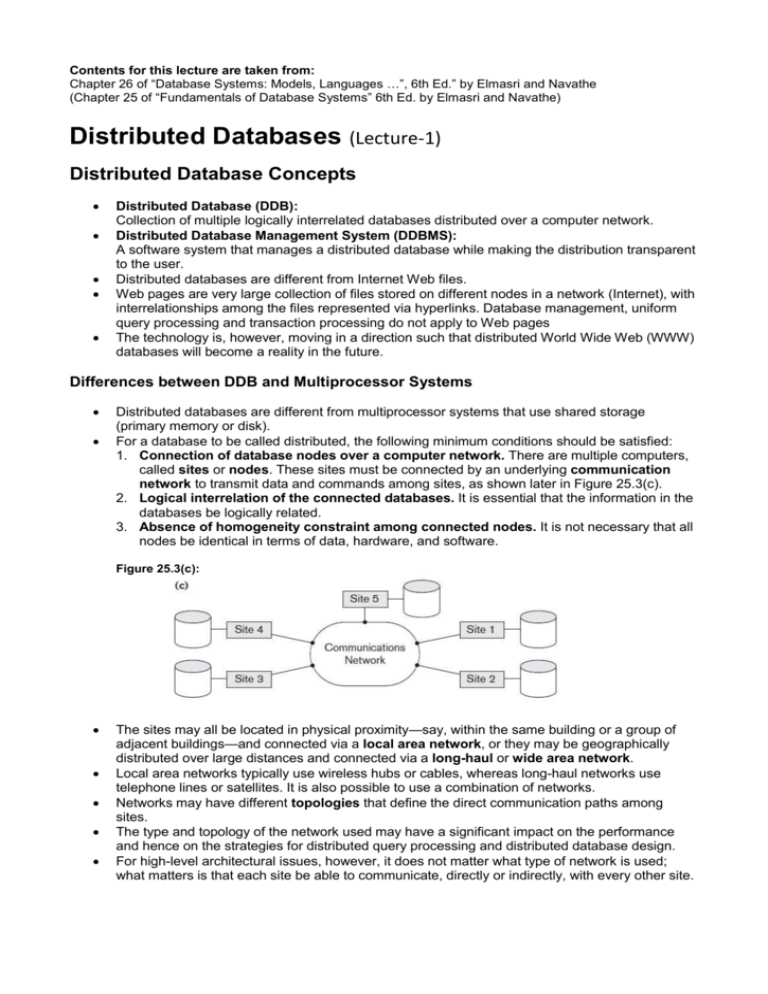
Contents for this lecture are taken from: Chapter 26 of “Database Systems: Models, Languages …”, 6th Ed.” by Elmasri and Navathe (Chapter 25 of “Fundamentals of Database Systems” 6th Ed. by Elmasri and Navathe) Distributed Databases (Lecture-1) Distributed Database Concepts Distributed Database (DDB): Collection of multiple logically interrelated databases distributed over a computer network. Distributed Database Management System (DDBMS): A software system that manages a distributed database while making the distribution transparent to the user. Distributed databases are different from Internet Web files. Web pages are very large collection of files stored on different nodes in a network (Internet), with interrelationships among the files represented via hyperlinks. Database management, uniform query processing and transaction processing do not apply to Web pages The technology is, however, moving in a direction such that distributed World Wide Web (WWW) databases will become a reality in the future. Differences between DDB and Multiprocessor Systems Distributed databases are different from multiprocessor systems that use shared storage (primary memory or disk). For a database to be called distributed, the following minimum conditions should be satisfied: 1. Connection of database nodes over a computer network. There are multiple computers, called sites or nodes. These sites must be connected by an underlying communication network to transmit data and commands among sites, as shown later in Figure 25.3(c). 2. Logical interrelation of the connected databases. It is essential that the information in the databases be logically related. 3. Absence of homogeneity constraint among connected nodes. It is not necessary that all nodes be identical in terms of data, hardware, and software. Figure 25.3(c): The sites may all be located in physical proximity—say, within the same building or a group of adjacent buildings—and connected via a local area network, or they may be geographically distributed over large distances and connected via a long-haul or wide area network. Local area networks typically use wireless hubs or cables, whereas long-haul networks use telephone lines or satellites. It is also possible to use a combination of networks. Networks may have different topologies that define the direct communication paths among sites. The type and topology of the network used may have a significant impact on the performance and hence on the strategies for distributed query processing and distributed database design. For high-level architectural issues, however, it does not matter what type of network is used; what matters is that each site be able to communicate, directly or indirectly, with every other site. Transparency The concept of transparency extends the general idea of hiding implementation details from end users. A highly transparent system offers a lot of flexibility to the end user/application developer since it requires little or no awareness of underlying details on their part. In the case of a traditional centralized database, transparency simply pertains to logical and physical data independence for application developers. However, in a DDB scenario, the data and software are distributed over multiple sites connected by a computer network, so additional types of transparencies are introduced. Consider the company database in Figure 3.5 that we have been discussing throughout the book. The EMPLOYEE, PROJECT, and WORKS_ON tables may be fragmented horizontally and stored with possible replication as shown in Figure 25.1. The following types of transparencies are possible: 1. Data organization transparency (also known as distribution or network transparency). This refers to freedom for the user from the operational details of the network and the placement of the data in the distributed system. It may be divided into location transparency and naming transparency. Location transparency: Command used to perform a task is independent of the location of the data and the location of the node where the command was issued. Naming transparency: Once a name is associated with an object, the named objects can be accessed unambiguously without additional specification as to where the data is located. 2. Replication transparency. As we show in Figure 25.1, copies of the same data objects may be stored at multiple sites for better availability, performance, and reliability. Replication transparency makes the user unaware of the existence of these copies. 3. Fragmentation transparency. Two types of fragmentation are possible: Horizontal fragmentation distributes a relation (table) into sub-relations that are subsets of the tuples (rows) in the original relation. Vertical fragmentation distributes a relation into sub-relations where each sub-relation is defined by a subset of the columns of the original relation. A global query by the user must be transformed into several fragment queries. Fragmentation transparency makes the user unaware of the existence of fragments. 4. Other transparencies include design transparency and execution transparency—referring to freedom from knowing how the distributed database is designed and where a transaction executes. Autonomy Autonomy determines the extent to which individual nodes or DBs in a connected DDB can operate independently. A high degree of autonomy is desirable for increased flexibility and customized maintenance of an individual node. Autonomy can be applied to design, communication, and execution. Design autonomy refers to independence of data model usage and transaction management techniques among nodes. Communication autonomy determines the extent to which each node can decide on sharing of information with other nodes. Execution autonomy refers to independence of users to act as they please. Reliability and Availability Most common potential advantages cited for distributed databases. Reliability: The probability that a system is running (not down) at a certain time point. Availability: The probability that the system is continuously available during a time interval. We can directly relate reliability and availability of the database to the faults, errors, and failures associated with it. Failure: Deviation of system’s behavior from correct execution of operations. Errors: The subset of system states that causes the failure. Fault: The cause of an error. To construct a system that is reliable, we can adopt several approaches: 1. Fault tolerance: Recognizes that faults will occur, and designs mechanisms that can detect and remove faults before they can result in a system failure. 2. To ensure that the final system does not contain any faults. This is done through an exhaustive design process followed by extensive quality control and testing. A reliable DDBMS tolerates failures of underlying components and processes user requests so long as database consistency is not violated. A DDBMS recovery manager has to deal with failures arising from transactions, hardware, and communication networks. Hardware failures can either be those that result in loss of main memory contents or loss of secondary storage contents. Communication failures occur due to errors associated with messages and line failures. Message errors can include their loss, corruption, or out-of-order arrival at destination. Advantages of Distributed Databases 1. Improved ease and flexibility of application development. Developing and maintaining applications at geographically distributed sites of an organization is facilitated owing to transparency of data distribution and control. 2. Increased reliability and availability Faults are isolated to their site of origin without affecting other connected databases. Only the data and software that exist at the failed site cannot be accessed. Replicating data and software at more than one site provides further improvement. If the data in the failed site had been replicated at another site prior to the failure, then the user will not be affected at all. 3. Improved performance Distributed DBMS fragments the database by keeping the data closer to where it is needed most. Data localization reduces the contention for CPU and I/O services and simultaneously reduces access delays involved in wide area networks. Local queries and transactions accessing data at a single site have better performance because of the smaller local databases. Each site has a smaller number of transactions executing than if all transactions are submitted to a single centralized database. Inter-query and intra-query parallelism can be achieved by executing multiple queries at different sites, or by breaking up a query into a number of subqueries that execute in parallel. This contributes to improved performance. 4. Easier expansion. In a distributed environment, expansion of the system in terms of adding more data, increasing database sizes, or adding more processors is much easier. Additional Functions of Distributed Databases To achieve the advantages listed previously, the DDBMS software must be able to provide the following functions in addition to those of a centralized DBMS: 1. Keeping track of data distribution. The ability to keep track of the data distribution, fragmentation, and replication by expanding the DDBMS catalog. 2. Distributed query processing. The ability to access remote sites and transmit queries and data among the various sites via a communication network. 3. Distributed transaction management. The ability to devise execution strategies for queries and transactions that access data from more than one site and to synchronize the access to distributed data and maintain the integrity of the overall database. 4. Replicated data management. The ability to decide which copy of a replicated data item to access and to maintain the consistency of copies of a replicated data item. 5. Distributed database recovery. The ability to recover from individual site crashes and from new types of failures, such as the failure of communication links. 6. Security. Distributed transactions must be executed with the proper management of the security of the data and the authorization/access privileges of users. 7. Distributed directory (catalog) management. A directory contains information about data (metadata) in the database. The directory may be global for the entire DDB, or local for each site. The placement and distribution of the directory are design and policy issues. Types of Distributed Database Systems Distributed Database Systems differ from one another in many respects. The common feature is that the data and software are distributed over multiple sites connected by some form of communication network. There are a number of types of DDBMSs and the criteria and factors that make some of these systems different. Degree of homogeneity of the DDBMS software. If all servers (or individual local DBMSs) use identical software and all users (clients) use identical software, the DDBMS is called homogeneous; otherwise, it is called heterogeneous. Degree of local autonomy. If there is no provision for the local site to function as a standalone DBMS, then the system has no local autonomy. On the other hand, if direct access by local transactions to a server is permitted, the system has some degree of local autonomy. Figure 25.2 shows classification of DDBMS alternatives along orthogonal axes of distribution, autonomy, and heterogeneity. For a centralized database, there is complete autonomy, no distribution and no heterogeneity (Point A in the figure). The term federated database system (FDBS) is used when there is some global view or schema of the federation of databases that is shared by the applications (Point C). A multi-database system has full local autonomy in that it does not have a global schema but interactively constructs one as needed by the application (Point D). Both systems (federated and multi-database) are hybrids between distributed and centralized systems, and the distinction we made between them is not strictly followed. We will refer to them as FDBSs in a generic sense. Point D in the diagram may also stand for a system with full local autonomy and full heterogeneity— this could be a peer-to-peer database system. In a heterogeneous FDBS, one server may be a relational DBMS, another a network DBMS and a third an object DBMS or hierarchical DBMS; in such a case, it is necessary to have a canonical system language and to include language translators to translate subqueries from the canonical language to the language of each server.

